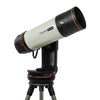Triple APOD - December 3, 2025: Comet A6 Lemmon by Edward Bogle
Comet A6 Lemmon made its closest approach to Earth in late October 2025. Visible to the naked eye, the comet will make its next appearance near Earth in ~1000 years time.
Related Products

Télescope d'observation domestique intelli...
Celestron a mis l'intégralité de ses connaissances, de ses compétences et de son héritage derrière ce nouvel et passionnant observatoire domestique...



